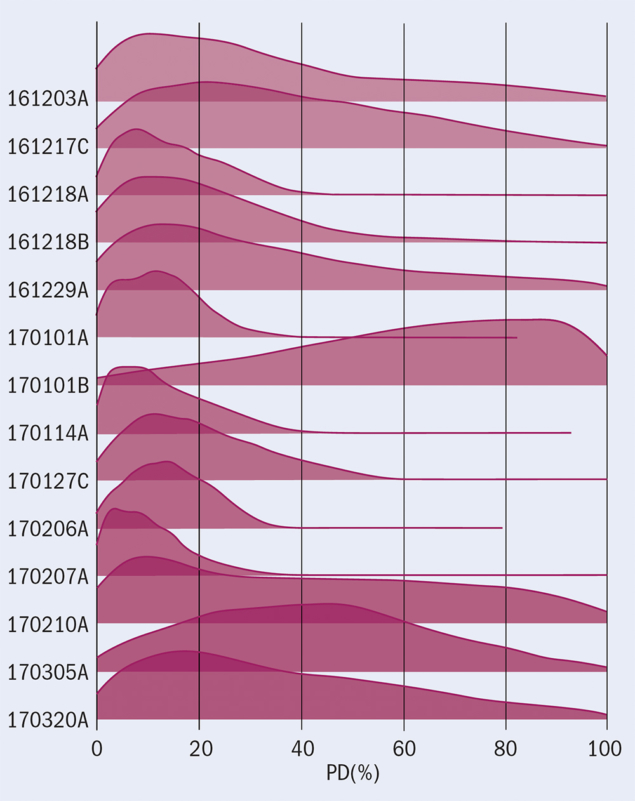
polarisation (PD) of various GRBs inferred from POLAR data, indicating that the emission is lowly polarised or unpolarised for the vast majority of events. This would imply that magnetic fields are not important in these bright explosions, but detailed studies paint a more complicated picture. Credit: POLAR
Recent years have seen the dawn of multi-messenger astrophysics. Perhaps the most significant contributor to this new era was the 2017 detection of gravitational waves (GWs) in coincidence with a bright electromagnetic phenomenon, a gamma-ray burst (GRB). GRBs consist of intense bursts of gamma rays which, for periods ranging from hundreds of milliseconds to hundreds of seconds, outshine any other source in the universe. Although the first such event was spotted back in 1967, and typically one GRB is detected every day, the underlying astrophysical processes responsible remain a mystery. The joint GW–electromagnetic detection answered several questions about the nature of GRBs, but many others remain.
Recently, researchers made the first attempts to add gamma-ray polarisation into the mix. If successful, this could enable the next step forward within the multi-messenger field.
So far, three photon parameters – arrival time, direction and energy – have been measured extensively for a range of different objects within astrophysics. Yet, despite the wealth of information it contains, the photon polarisation has been neglected. X-ray or gamma-ray fluxes emitted by charged particles within strong magnetic fields are highly polarised, while those emitted by thermal processes are typically unpolarised. Polarisation therefore allows researchers to easily identify the dominant emission mechanism for a particular source. GRBs are one such source, since a consensus on where the gamma rays actually originate from is still missing.
Difficult measurements
The reason that polarisation has not been measured in great detail is related to the difficulty of performing the measurements. To measure the polarisation of an incoming photon, details of the secondary products produced as it interacts in a detector need to be measured. With gamma rays, for example, the angle at which the gamma ray scatters in the detector is related to its polarisation vector. This means that, in addition to detecting the photon, researchers need to study its subsequent path. Such measurements are further complicated by the need to perform them above the atmosphere on satellites, which complicates the detector design significantly.
The 2020s should see the start of a new type of astrophysics
Recent progress has shown that, although challenging, polarisation measurements are possible. The most recent example came from the POLAR mission, a Swiss, Polish and Chinese experiment fully dedicated to measuring the polarisation of GRBs, which took data from September 2016 to April 2017. The team behind POLAR, which was launched to space in 2016 attached to a module for the China Space Station, recently published its first results. Though they indicate that the emission from GRBs is likely unpolarised, the story appears to be more complex. For example, the polarisation is found to be low when looking at the full GRB emission, but when studying it over short time intervals, a strong hint of high polarisation is found with a rapidly changing polarisation angle during the GRB event. This rapid evolution of the polarisation angle, which is yet to be explained by the theoretical community, smears out the polarisation when looking at the full GRB. In order to fully understand the evolution, which could give hints of an evolution of a magnetic field, finer time-binning and more precise measurements are needed, which require more statistics.
POLAR-2
Two future instruments capable of providing such detailed measurements are currently being developed. The first, POLAR-2, is the follow-up of the POLAR mission and was recently recommended to become a CERN-recognised experiment. P OLAR-2 w ill b e a n order of magnitude more sensitive (due to larger statistics and lower systematics) than its predecessor and therefore should be able to answer most of the questions raised by the recent POLAR results. The experiment will also play an important role in detecting extremely weak GRBs, such as those expected from GW events. POLAR-2, which will be launched in 2024 to the under-construction China Space Station, could well be followed by a similar but slightly smaller instrument called LEAP, which recently progressed to the final stage of a NASA selection process. If successful, LEAP would join POLAR-2 in 2025 in orbit on the International Space Station.
Apart from dedicated GRB polarimeters, progress is also being made at other upcoming instruments such as NASA’s Imaging X-ray Polarimetry Explorer and China-ESA’s enhanced X-ray Timing and Polarimetry mission, which aim to perform the first detailed polarisation measurements of a range of astrophysical objects in the X-ray region. While the first measurements from POLAR have been published recently, and more are expected soon, the 2020s should see the start of a new type of astrophysics, which adds yet another parameter to multi-messenger exploration.
Further reading
S Zhang et al. 2019 Nat. Astron. 3 258.







